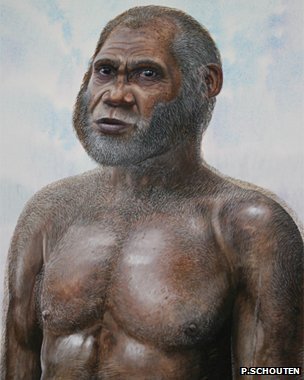The remains of at least five individuals from a previously unknown human species have been identified in southern China.
The bones have been dated to between 11,500 and 14,500 years ago.
Scientists are calling them simply the Red Deer Cave people, after one of the sites where they were unearthed.
The team has told the PLoS One journal that far more detailed analysis of the fossils is required before they can be ascribed to a new human lineage.
“We’re trying to be very careful at this stage about definitely classifying them,” said study co-leader Darren Curnoe from the University of New South Wales, Australia.
“One of the reasons for that is that in the science of human evolution or palaeoanthropology, we presently don’t have a generally agreed, biological definition for our own species (Homo sapiens), believe it or not. And so this is a highly contentious area,” he said.
Much of the material has been in Chinese collections for some time but has only recently been subjected to intense investigation.

The remains of some of the individuals come from Maludong (or Red Deer Cave), near the city of Mengzi in Yunnan Province. A further skeleton was discovered at Longlin, in neighboring Guangxi Province.
The skulls and teeth from the two locations are very similar to each other, suggesting they are from the same population.
But their features are quite distinct from what you might call a fully modern human, says the team. Instead, the Red Deer Cave people have a mix of archaic and modern characteristics.

In general, the individuals had rounded brain cases with prominent brow ridges. Their skull bones were quite thick. Their faces were quite short and flat and tucked under the brain, and they had broad noses.
Their jaws jutted forward but they lacked a modern-human-like chin. Computed Tomography (X-ray) scans of their brain cavities indicate they had modern-looking frontal lobes but quite archaic-looking anterior, or parietal, lobes. They also had large molar teeth.
Dr. Darren Curnoe and colleagues put forward two possible scenarios in their PLoS One paper for the origin of the Red Deer Cave population.
One posits that they represent a very early migration of a primitive-looking Homo sapiens that lived separately from other forms in Asia before dying out.
Another possibility contends that they were indeed a distinct Homo species that evolved in Asia and lived alongside our own kind until remarkably recently.
A third scenario being suggested by scientists not connected with the research is that the Red Deer Cave people could be hybrids.
“It’s possible these were modern humans who inter-mixed or bred with archaic humans that were around at the time,” explained Dr. Isabelle De Groote, a palaeoanthropologist from London’s Natural History Museum.
“The other option is that they evolved these more primitive features independently because of genetic drift or isolation, or in a response to an environmental pressure such as climate.”
Dr. Darren Curnoe agreed all this was “certainly possible”.
Attempts are being made to extract DNA from the remains. This could yield information about interbreeding, just as genetic studies have on the closely related human species – the Neanderthals and an enigmatic group of people from Siberia known as the Denisovans.
Whatever their true place in the Homo family tree, the Red Deer People are an important find simply because of the dearth of well dated, well described specimens from this part of the world.
And their unearthing all adds to the fascinating and increasingly complex story of human migration and development.
“The Red Deer People were living at what was a really interesting time in China, during what we call the epipalaeolithic or the end of the Stone Age,” says Dr. Darren Curnoe.
“Not far from Longlin, there are quite well known archaeological sites where some of the very earliest evidence for the epipalaeolithic in East Asia has been found.
“These were occupied by very modern looking people who are already starting to make ceramics – pottery – to store food. And they’re already harvesting from the landscape wild rice. There was an economic transition going on from full-blown foraging and gathering towards agriculture.”
Quite how the Red Deer People fit into this picture is unclear. The research team is promising to report further investigations into some of the stone tools and cultural artefacts discovered at the dig sites.
The co-leader on the project is Professor Ji Xueping of the Yunnan Institute of Cultural Relics and Archaeology.
